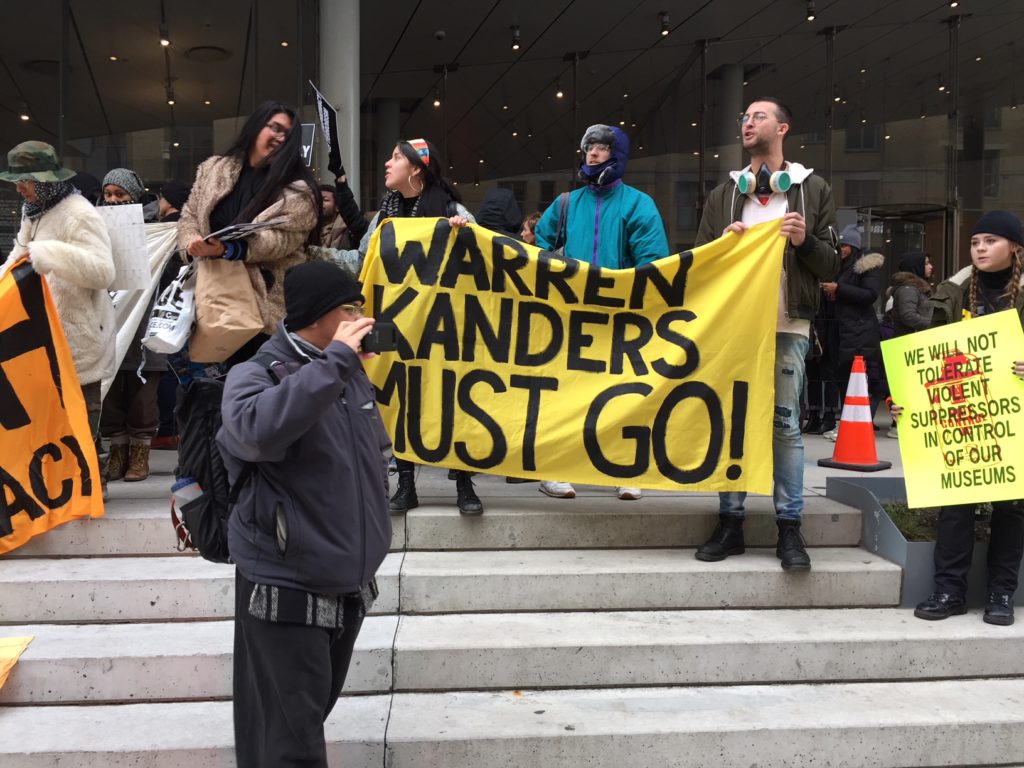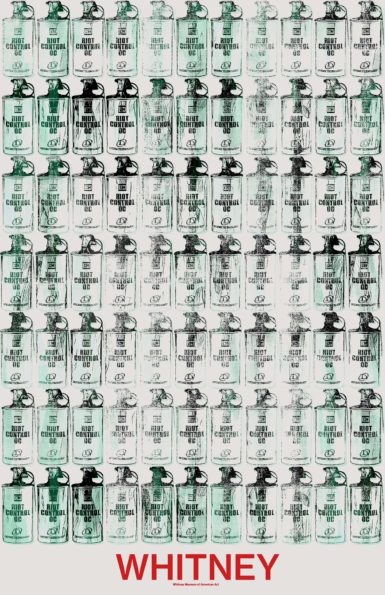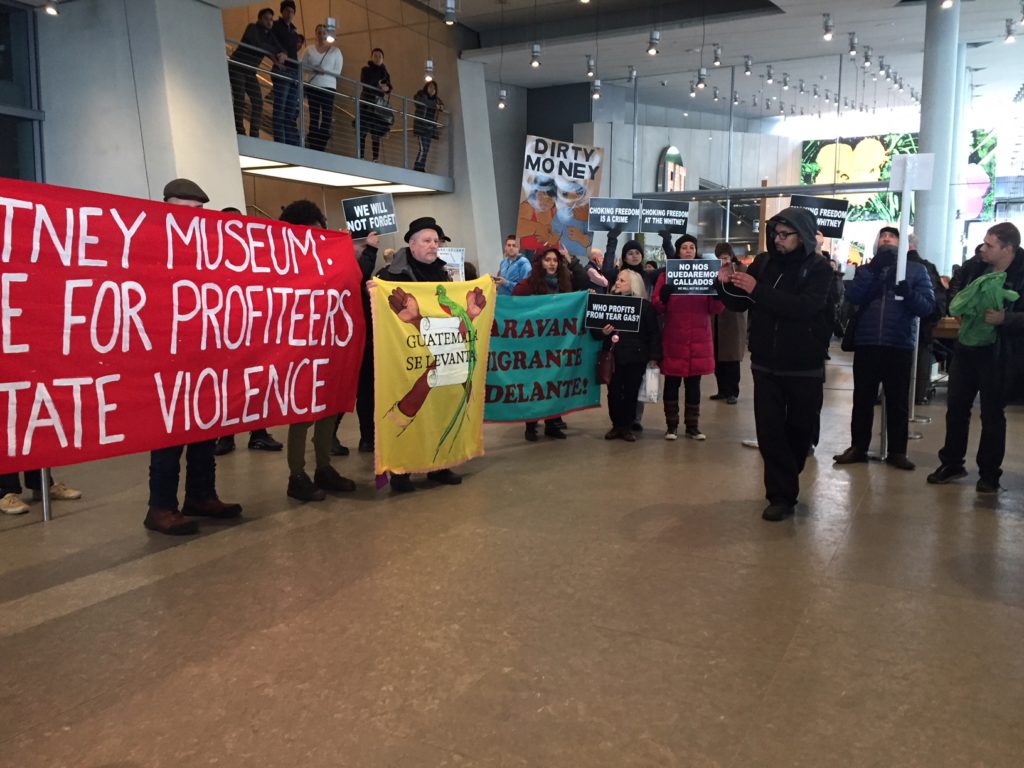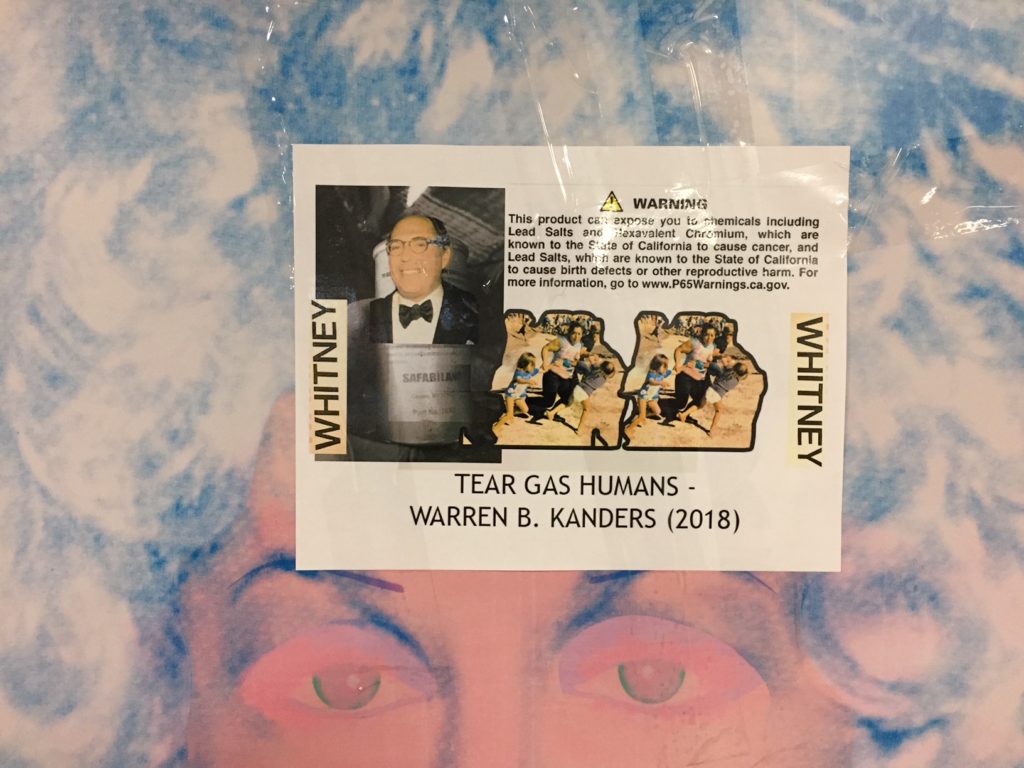[ad_1]

Decolonize This Place’s protest at the Whitney Museum in New York today.
ALEX GREENBERGER/ARTNEWS
Earlier this afternoon, the smell of burning sage and chants of “Decolonize this museum!” filled the lobby of the Whitney Museum in New York, where the activist group Decolonize This Place led a protest meant to raise awareness of the involvement of Warren B. Kanders, the vice chair of the museum’s board, in Safariland, a company that has manufactured tear gas canisters and other products that have been used against asylum seekers on the U.S.-Mexico border.
The protest included speeches from members of the American Indian House, the Bronx-based Hydro Punk movement, and the New Sanctuary Coalition, and implicated Kanders’s involvement in the Whitney within larger global histories of colonialism, queer erasure, gentrification, class struggle, and violence. At one point, protesters were forced to leave the Whitney’s lobby by the Fire Department, which arrived on the scene after smoke from the burning sage had set off alarms.

A poster by Decolonize This Place and MTL+ disseminated at today’s protest.
COURTESY DECOLONIZE THIS PLACE AND MTL+
The protest comes following three open letters. The first, which was circulated internally at the Whitney, was signed by 95 museum employees and demanded that leadership consider asking Kanders to resign from his position at the institution. “To remain silent is to remain complicit,” the signees of that letter wrote. That missive followed a report by Hyperallergic that brought to the fore Kanders’s ownership of Safariland. (Decolonize This Place has said that the protest is “autonomous from, but in solidarity with” Whitney staff.)
This past Monday, two more letters followed. In a note to Whitney staff, museum director Adam Weinberg said that he wanted to create a space for dialogue. And in another letter, Kanders defended himself against the Whitney staff members who penned their statement, writing, “The staff letter implies that I am responsible for the decision to use these products. I am not.”
Promotional materials for the protest included imagery created by Decolonize This Place and the collective MTL+ mixing pictures related to Safariland and advertisements for the Whitney’s current Andy Warhol retrospective, for which Kanders is listed as a “significant contributor.”
At around noon, Decolonize This Place’s assembly began outside the museum, under the High Line, where activists, artists, and curious onlookers alike mingled around a set of banners the group had produced. “WHITNEY MUSEUM: NO SPACE FOR PROFITEER OF STATE VIOLENCE,” one of these banners read. Others evoked issues related to the repatriation of cultural objects and the current refugee crisis. New York Magazine art critic Jerry Saltz was among the attendees during the early stages of the protest, which began with a declaration by one activist that the action was about to take place on Lenape land.

Protesters at Decolonize This Place’s action at the Whitney Museum in New York.
ALEX GREENBERGER/ARTNEWS
Statements printed in English and Spanish were handed out at the protest that read, in part:
Need we remind Weinberg that “the laws of society” have included the legal sanctioning of slavery, the Indian Removal Act, Jim Crow laws, and indeed the entire juridico-economic regime of settler colonialism, white supremacy, and capitalism that underpins contemporary U.S. society?
We say to Weinberg: We are not fools. We know law is not justice. Your statement makes it clear which side you are on: the side of Safariland, and this we simply cannot accept.”
Demands from that statement were also read in both English and Spanish. These demands included a call for international solidarity beyond the U.S. and Mexico, prosecution of officials who limit the rights of asylum seekers, and U.S. government acknowledgement of its role in the 2009 coup d’état in Honduras and other political and social events in Central America.
At around 1 p.m., leaders from Decolonize This Place began moving the protest into the lobby. Museum officials tried to contain the protesters through a series of lines, but those lines did not hold long, and soon banners were laid on the floor and bundles of sage were being lighted.
“Warren Kanders is the 1 percent, and also happens to own a company called Safariland,” the artist Shellyne Rodridguez announced to those assembled in the lobby. “Let us marinate on how fucked up and colonial that company’s name is.” She went on to explain that, because it receives funding from Kanders, the Whitney and its Warhol show could not be divorced from a host of political issues in such countries as El Salvador, Guatemala, and Mexico.

A sign by Decolonize This Place taped to an advertisement for the Whitney Museum’s Andy Warhol retrospective.
ALEX GREENBERGER/ARTNEWS
She went on: “We cannot let this motherfucker maintain his presence at this museum. It’s the least we can do.”
Rick Chavolla, a member of the Kumeyaay people and the chair of the American Indian Community House, told the crowd, “Sage is medicine. Tear gas is poisonous.” He went on to explain that his organization had spent the past couple years working with Whitney leadership to develop initiatives that could reach indigenous communities. “To build relations with our communities,” he said, “they must stop spreading poison.”
By 1:30 p.m., so much sage had been burned that the lobby was covered in a thick layer of smoke. Only a bit earlier, protesters had begun chanting, “Fire! Fire! Fire to the colonizers!” And as if on cue, the Fire Department entered and demanded the sage be put out. Members of the crowd then began shouting “Colonizers!” at the firefighters. But, for the most part, the protest peacefully relocated to the steps near the museum’s entrance, where they repeatedly shouted, “Decolonize this museum!”
ARTnews has reached out to the museum for comment on the event, and will update this post.
[ad_2]
Source link

